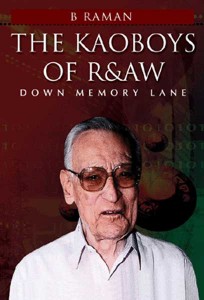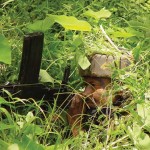A spook spends his working life in a cloistered world—protecting himself, his relatives, his feelings and his joys and sorrows from unwanted curiosity.
The special bonds that one develops in this world last till one makes one’s peace with the Maker.
Amar Bhushan is one of the officers of the R&AW with whom I developed special bonds of friendship, professional regard and affection.
Penetration by a foreign intelligence agency is an occupational hazard in the intelligence profession.
He joined the Indian Police Service almost a decade after I did and retired from the R&AW 11 years after me.
He was my junior colleague in my division for some years after he set foot in the organisation. Thereafter, he moved to other divisions with which I had nothing to do, but the special bonds between us remained strong and unrusted.
He was a man of tremendous personal and professional integrity, with an eye for thoroughness in whatever he did—- a professional to his finger tips.
After a distinguished career during which he became a highly valued expert on Bangladesh, he retired as Special Secretary in 2005.
Amar wore many hats in that capacity. One of them was as the R&AW’s Czar of counter-intelligence responsible for preventing, detecting and neutralising attempts of foreign intelligence agencies to penetrate the R&AW and subvert the loyalty of its officers.
Under that hat, he played a commendable role in detecting, with the help of his junior colleagues, the penetration of the R&AW by the USA’s Central Intelligence Agency (CIA) through Maj Rabinder Singh, a retired officer of the Army who joined the organisation in the 1980s.
One does not know when Rabinder became a mole of the CIA? Was he already a mole when he was in the Army? Or was he recruited by the CIA after he joined the organisation? If so, when?
We reportedly found a mole even after the detection of Rabinder in the National Security Council Secretariat, which is part of the Prime Minister’s Office… These were the detected cases. One does not know how many undetected cases are there.
What role his sister, who was a US citizen and who was a US Government public servant, played in facilitating the penetration of the R&AW by the CIA through her brother? Was it wise and professional on the part of the R&AW to have taken into the organisation someone many of whose relatives were US citizens and at least one of whom was a public servant of the US?
What damage did he cause to the organisation and the country during the period he was a CIA mole in the sanctum sanctorum of the R&AW?
Penetration by a foreign intelligence agency is an occupational hazard in the intelligence profession.
Rabinder was not the first mole of the CIA in the Indian intelligence community.
We had another in the Chennai office of the R&AW detected in the 1980s.He was allegedly being run by a CIA officer working under Consular cover in the US Consulate-General in Chennai.
We had one at a very senior level in the Intelligence Bureau detected in the 1990s. If he had not been detected in time, he might have become the head of the IB. A woman officer of the CIA working under cover in the US Embassy in Delhi for maintaining liaison with the Indian intelligence had allegedly become close to him by exploiting her frequent meetings with him for sharing intelligence on counter-terrorism.
We reportedly found a mole even after the detection of Rabinder in the National Security Council Secretariat, which is part of the Prime Minister’s Office. A woman cyber security expert of the US had allegedly played a role in this case.
These were the detected cases. One does not know how many undetected cases are there.
Of the four detected cases, that of Rabinder was unique. Whereas the other three were detected and acted against without their being able to run away from the country. Rabinder was the one that got away evading the surveillance that had been mounted on him.
His getting away was made possible by the active assistance reportedly given by the CIA to him and his family.
In India, any scholar who wants to reconstruct L’Affaire Rabinder Singh on the basis of authentic data will not be able to do so because nothing is available in public domain.
In the other three cases, the CIA merely withdrew its officers working under cover in India after it came to know that its moles in the Indian intelligence community had come under suspicion by the Indian counter-intelligence.
It did not try to help them to get away.
Only in the case of Rabinder, even at the risk of an adverse impact on the State-to-State relations with India, the CIA seems to have moved heaven and earth to help him get away into the safe sanctuary of the US.
Why did it do so? Was it in gratitude for the invaluable services that he might have rendered to the CIA? Or was it due to fears that if arrested and interrogated by the Indian counter-intelligence, he might under duress reveal the identities of other CIA moles in the Indian intelligence community of whom he possibly had knowledge?
So many questions without answers in the public domain.
When Aldrich Ames, the notorious spy of the KGB in the sanctum sanctorum of the CIA, was detected and arrested in the 1990s, there were detailed enquiries in-house in the CIA as well as by the Congressional oversight committees.
The entire history of Ames as a KGB mole was traced. How was he recruited? How did he manage to evade detection for many years? What were the deficiencies in the CIA’s CI set-up which he and the KGB exploited? What damage did he cause?
Many of the details of these enquiries were made available in the public domain. You can find them in the Congressional records.
In India, any scholar who wants to reconstruct L’Affaire Rabinder Singh on the basis of authentic data will not be able to do so because nothing is available in public domain.
Whatever we have are speculative reports carried by the media.
In this context, one has to welcome reports carried by sections of the media on July 15, 2012, that Amar has written a semi-fictional narrative of the case (Escape To Nowhere), which is being published this week and will be launched in Delhi on July 23.
Knowing the central, active and leading role that Amar played in this case, one can be certain it will not be just a semi-fiction as it has been projected to be.
It will be a critical analysis incognito.
Amar needs to be hailed for writing this. It will be an important contribution to the meagre history of Indian intelligence available in public domain.
It will throw welcome light on a sad chapter in the history of the R&AW.
Strength to you, Amar.
This article was first published in 16 July, 2012.






Even if Rabinder defected why haven’t we gone for him in the US. What stops an intelligence agency from hiring mercenary hitman to do the guy in, in the US. Its just our pacifist attitude. The guy in Chennai was looking after the Sri Lanka desk and was compromised by an air hostess of the Singapore Airlines — that’s what we heard. Compromised people should be dealt with harshly, that’s the right message.
Mr. B Raman’s articles have always been incisive and impact-full. This piece indeed reveals a tip of an iceberg and as he asks, how may more there may be may not get known at all. Since ancient times, Indians have had a penchant for secrecy, so much so that even secrets, the exposure of which may be in the interest of the country remain buried. With the scourge of Pak army sponsored terror that India is suffering from, it needs to build or re-build (as one believes we had developed it in the past) covert external strike capability. If we have it, it must be strengthened to the extent that it begins to have telling effect on terrorist groups for whom striking at India is usually cakewalk. And then take the case of the proven terrorist attacker of 26/11, Ajmal Kasab, whose maintenance in jail is costing crores of the tax-payers money.